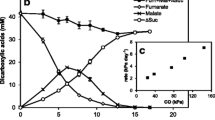Abstract
Spectroscopy at room and liquid nitrogen temperatures with extracts of the carbon monoxide-oxidizing bacteria Pseudomonas carboxydovorans, P. carboxydohydrogena, P. carboxydoflava, P. compransoris, Alcaligenes carboxydus, and Arthrobacter 11/x revealed the presence of normal electron transport systems, containing b-, c-, and a-type cytochromes at concentrations that compare to those of other aerobic bacteria. CO did not induce the formation of special CO-insensitive terminal oxidases. The gross composition of the respiratory chains was not affected by the type of growth substrate, and cytochrome d(=a2) was not detected. However, certain b-type cytochromes were only found when CO or H2 + CO2 served as growth substrates. All strains contained at least two different b-type cytochromes. Cytochrome b563 formed a weak CO-complex and was identified as a novel cytochrome o. It functions as CO-insensitive, alternative terminal oxidase in carboxydotrophic bacteria. A soluble CO-binding cytochrome c was present in P. carboxydovorans, P. carboxydohydrogena, and P. carboxydoflava. A CO-binding protoheme compound could be identified as catalase in P. compransoris, P. carboxydovorans, P. carboxydohydrogena, A. carboxydus, and Arthrobacter 11/x. The data are consistent with the presence of branched respiratory chains in the carboxydotrophs examined, and suggest the functioning of both, cytochrome a and the novel cytochrome o as terminal oxidases.
Similar content being viewed by others
References
Arima K, Oka T (1965) Cyanide resistance in Achromobacter. I. Induced formation of cytochrome a2 and its role in cyanide-resistant respiration. J Bacteriol 90:734–743
Bernard U, Probst I, Schlegel HG (1974) The cytochromes of some hydrogen bacteria. Arch Microbiol 95:29–37
Bradford MM (1976) A rapid and sensitive method for the quantitation of microgram quantities of protein, utilizing the principle of protein dye binding. Anal Biochem 72:248–254
Broberg PL, Smith L (1967) The cytochrome system of Bacillus megaterium KM. The presence and some properties of two CO-binding cytochromes. Biochim Biophys Acta 131:479–489
Chance B, Williams GR (1956) The respiratory chain and oxidative phosphorylation. Adv Enzymol 17:65–134
Cypionka H (1982) Kohlenmonoxid-insensitive Atmung: Elektronentransport and terminale Oxidasen in carboxydotrophen Bakterien. Ph D thesis, Univ Göttingen, West Germany, pp 181
Cypionka H, Meyer O (1982a) Influence of carbon monoxide on growth and respiration of carboxydobacteria and other aerobic organisms. FEMS Microbiol Lett 15:209–214
Cypionka H, Meyer O (1982b) Why carboxydobacteria are insensitive to carbon monoxide. Zbl Bakt Hyg, I. Abt C 3:534
Daniel RH (1970) The electron transport system of Acetobacter suboxydans with particular reference to cytochrome o. Biochim Biophys Acta 216:328–341
Eberhardt U (1969) On chemolithotrophy and hydrogenase of a grampositive Knallgas bacterium. Arch Mikrobiol 66:91–104
Estabrook RW (1961) Spectrophotometric studies of cytochromes cooled in liquid nitrogen. In: Falk JE, Lemberg R, Morton RK (eds) Haematin enzymes, vol 2. Pergamon Press, Oxford, pp 436–457
Jurtshuk JrP, Yang T (1980) Oxygen reactive hemoprotein compounds in bacterial respiratory systems. In: Knowles CJ (ed) Diversity of bacterial respiratory systems, vol 1. CRC Press, Florida, pp 137–159
Jurtshuk JrP, Mueller TJ, Acord WC (1975) Bacterial terminal oxidases. CRC Crit Rev Microbiol 3:399–468
Kamen MD, Horio T (1970) Bacterial cytochromes. I. Structural aspects. Ann Rev Biochem 39:673–700
Kim YM, Hegeman GD (1981) Electron transport system of an aerobic carbon monoxide-oxidizing bacterium. J Bacteriol 148:991–994
Kim YM, Hegeman GD (1983) Oxidation of carbon monoxide by bacteria. Int Rev Cytol, in press
Klemme JH, Schlegel HG (1969) Untersuchungen zum Cytochromoxidase-System aus anaerob im Licht and aerob im Dunkeln gewachsenen Zellen von Rhodopseudomonas capsulata. Arch Mikrobiol 68:326–354
La Rivière JWM (1958) On the microbial metabolism of the tartaric acid isomers. Ph D thesis, University of Delft, The Netherlands
Lebedinskii AV, Ivanovskii RN, Nozhevnikova AN (1976) Composition and content of cytochromes in cells of carboxide bacteria. Microbiology (USSR) 45:160–161
Meyer O, Schlegel HG (1978) Reisolation of the carbon monoxide utilizing hydrogen bacterium Pseudomonas carboxydovorans (Kistner) comb. nov. Arch Microbiol 118:35–43
Meyer O, Schlegel HG (1983) Biology of aerobic carbon monoxide-oxidizing bacteria. Ann Rev Microbiol 37:277–310
Meyer O, Lalucat J, Schlegel HG (1980) Pseudomonas carboxydohydrogena (Sanjieva and Zavarzin) comb. nov., a monotrichous, nonbudding, strictly aerobic, carbon monoxide-utilizing hydrogen bacterium, previously assigned to the genus Seliberia. Int J Syst Bacteriol 30:436–440
Nies D, Schlegel HG (1982) Catalase from Comamonas compransoris. J Gen Appl Microbiol 28:311–319
Nozhevnikova AN, Zavarzin GA (1974) On the taxonomy of CO-oxidizing gram negative bacteria. Izv Akad Nauk SSSR, Ser Biol 3:436–440
Probst I, Schlegel HG (1976) Respiratory components and oxidase activities in Alcaligenes eutrophus. Biochim Biophys Acta 440:412–428
Sanjieva EU, Zavarzin GA (1971) Oxidation of carbon monoxide by Seliberia carboxydohydrogena. Dokl Akad Nauk SSSR 196:956–958
Söder G (1980) Vergleichende wachstumsphysiologische und taxonomische Untersuchungen an Stämmen Kohlenmonoxid oxidierender Bakterien. Diplom thesis, Univ Göttingen, West Germany, pp 83
Van Gelder BF (1966) On cytochrome c oxidase. I. The extinction coefficients of cytochrome a and cytochrome a3. Biochim Biophys Acta 118:36–46
Van Verseveld HW, Braster M, Boogerd FC, Chance B, Stouthamer AH (1983) Energetic aspects of growth of Paracoccus denitrificans: Oxygen limitation and shift from anaerobic nitrate-limitation to aerobic succinate-limitation. Evidence for a new alternative oxidase, cytochrome a1. Arch Microbiol, in press
Warburg O (1926) Über die Wirkung des Kohlenoxyds auf den Stoffwechsel der Hefe. Biochem Z 177:471–486
Zannoni D, Baccarini-Melandri A, Melandri B, Evans EH, Prince RC, Crofts AR (1974) Energy transduction in photosynthetic bacteria. The nature of cytochrome c oxidase in the respiratory chain of Rhodopseudomonas capsulata. FEBS Lett 48:152–155
Zavarzin GA, Nozhevnikova AN (1977) Aerobic carboxydobacteria. Microb Ecol 3:305–326
Author information
Authors and Affiliations
Rights and permissions
About this article
Cite this article
Cypionka, H., Meyer, O. The cytochrome composition of carboxydotrophic bacteria. Arch. Microbiol. 135, 293–298 (1983). https://doi.org/10.1007/BF00413484
Received:
Accepted:
Issue Date:
DOI: https://doi.org/10.1007/BF00413484




